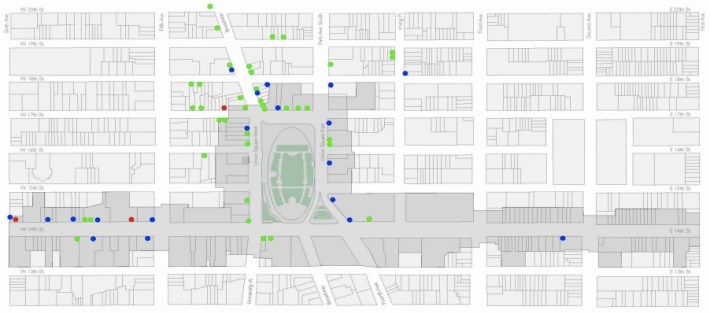
It's been a year since DOT made more room for pedestrians and cyclists around Union Square, and a recent survey shows a neighborhood happy with its new public spaces.
Feedback from businesses and residents led DOT to back away from its original proposal to, among other things, close two blocks of Union Square West to drivers during part of each day. Recognizing that remaining opponents were hopelessly intransigent, the local community board ultimately approved the plan by a vote of 24-1. By last September the changes were in place. In addition to installing roomy new public plazas, the city extended the protected bike lane on Broadway through 17th Street and around Union Square.
In August the Union Square Partnership collected surveys from 60 area businesses asking what they thought of the redesign. Thirty-six said it was a "good thing," 21 had no opinion and three thought it was a "bad thing" [PDF]. Even the three who disapprove admitted that it hadn't hurt their business. According to the New York Times, no businesses or store managers complained to elected officials, either.
"The vast majority of visitors in the district arrive on foot and public transportation, therefore the enhanced pedestrian environment has made the area more attractive to shoppers and diners," explained Jennifer Falk, the executive director of the Union Square Partnership.
Most important, the streets are safer. On Broadway north of the square, for example, DOT reports the share of vehicles speeding dropped from 28 percent to 12 percent after the redesign [PDF]. Pedestrians crossing 17th Street at Broadway were given more than twice as much time to cross a street that is almost half as wide as before.
At the same time, motor vehicle speeds were not negatively affected by the changes. Taxi speeds fell by four percent on Fifth Avenue but rose by 14 percent on 18th Street, where the worst congestion was predicted by project opponents. On Park Avenue, speeds rose by marginal amounts.
Business people who were previously opposed came around to the plan, said Falk. "Their major concerns -- increased traffic congestion, difficulty finding parking, delivery problems -- never came to fruition," she said. "Vehicles adapted to the new traffic patterns without disrupting normal flows."
A broader Partnership survey, which included area residents, employees and visitors, found that 74 percent liked the new traffic pattern, with only 16 percent opposed.
DOT made some alterations after installation and plans to make more adjustments. Already, a few signals have been re-timed. A traffic calming neckdown was removed at 17th and Park while another was shaved down to make for easier vehicular turns at Broadway and 22nd. To alleviate crosstown traffic congestion, DOT is considering installing additional turn lanes at certain locations.





